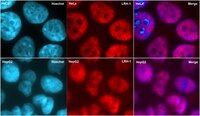MABE215 Sigma-AldrichAnti-Liver receptor homolog-1 Antibody, clone 1LRH-2E1
Use Anti-LRH-1 Antibody, clone 1LRH-2E1 (Mouse Monoclonal Antibody) validated in WB, ICC to detect LRH-1 also known as Liver receptor homolog 1.
More>> Use Anti-LRH-1 Antibody, clone 1LRH-2E1 (Mouse Monoclonal Antibody) validated in WB, ICC to detect LRH-1 also known as Liver receptor homolog 1. Less<<Recommended Products
Overview
| Replacement Information |
|---|
Key Spec Table
| Species Reactivity | Key Applications | Host | Format | Antibody Type |
|---|---|---|---|---|
| M | WB, ICC | M | Ascites | Monoclonal Antibody |
| References |
|---|
| Product Information | |
|---|---|
| Format | Ascites |
| Control |
|
| Presentation | Mouse monoclonal IgG2aλ ascites with 0.05% sodium azide. |
| Quality Level | MQ100 |
| Physicochemical Information |
|---|
| Dimensions |
|---|
| Materials Information |
|---|
| Toxicological Information |
|---|
| Safety Information according to GHS |
|---|
| Safety Information |
|---|
| Packaging Information | |
|---|---|
| Material Size | 100 µL |
| Transport Information |
|---|
| Supplemental Information |
|---|
| Specifications |
|---|
| Global Trade Item Number | |
|---|---|
| Catalogue Number | GTIN |
| MABE215 | 04053252522215 |
Documentation
Anti-Liver receptor homolog-1 Antibody, clone 1LRH-2E1 SDS
| Title |
|---|









